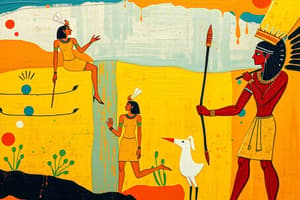Podcast
Questions and Answers
What was a primary focus of prehistoric art?
What was a primary focus of prehistoric art?
- Focus on daily life activities
- Intricate religious symbolism
- Depictions of mythological scenes
- Large animals and human figures (correct)
Which characteristic is NOT associated with Ancient Egyptian art?
Which characteristic is NOT associated with Ancient Egyptian art?
- Dynamic scenes of battle (correct)
- Emphasis on the afterlife
- Depictions of pharaohs and gods
- Rich religious symbolism
What notable art techniques were prevalent during the Classical Greek era?
What notable art techniques were prevalent during the Classical Greek era?
- Fresco and encaustic painting (correct)
- Mosaic and mural techniques
- Textile art and embroidery
- Woodworking and metal casting
Roman art was heavily inspired by which earlier tradition?
Roman art was heavily inspired by which earlier tradition?
The Byzantine era is recognized for its focus on what type of themes?
The Byzantine era is recognized for its focus on what type of themes?
What best describes the style of Romanesque painting?
What best describes the style of Romanesque painting?
Why were Egyptian paintings found in sarcophagi significant?
Why were Egyptian paintings found in sarcophagi significant?
What type of scenes were commonly depicted in Greek pottery?
What type of scenes were commonly depicted in Greek pottery?
What is a characteristic of Byzantine art?
What is a characteristic of Byzantine art?
Which era is recognized for its innovative use of mosaics?
Which era is recognized for its innovative use of mosaics?
Flashcards are hidden until you start studying
Study Notes
Overview of Western Classical Art Tradition
- Art functions as a medium for expressing emotions and ideas, facilitating communication across diverse cultures and historical periods.
- Essential inquiries center on distinct eras in Western classical art, their defining characteristics, and overarching themes.
Prehistoric Era
- Predominantly composed of cave paintings, serving as early communication methods linked to religious or ceremonial practices.
- Artworks often depicted large animals and human figures, reflecting the lifestyles and beliefs of prehistoric communities.
Ancient Egyptian Art
- Paintings in sarcophagi illustrated the deceased's life events and scenes designed to ensure a favorable afterlife.
- Heavy emphasis on the afterlife, with rich religious symbolism showcasing pharaohs and gods.
Classical Greek Era
- Greek artworks on pottery and walls featured dynamic scenes from battle and mythology, marked by naturalistic representations.
- Notable techniques included fresco and encaustic painting, showcasing significant technical progress.
Roman Era
- Roman art was heavily influenced by Greek precedents while introducing innovations such as panorama paintings and mosaics.
- Artworks depicted diverse subjects, including everyday life and mythology, primarily serving decorative functions in public and private spaces.
Byzantine Influence
- Byzantine art integrated elements from Greek and Roman traditions, focusing predominantly on Christian themes.
- Recognized for grand church decorations rich in spirituality and intricate religious artwork details.
Romanesque Characteristics
- Characterized by rigid frontal poses and focused on biblical figures within the painting.
- Exhibited a blend of artistic traditions, including Moorish influence, highlighting narrative and symbolism within a church context.
Gothic Artistic Developments
- The Gothic period marked a transition towards manuscript illumination and elaborate wall paintings that narrated biblical stories.
- Iconic features include stained glass rose windows that illuminated cathedrals, reinforcing a sacred atmosphere.
Studying That Suits You
Use AI to generate personalized quizzes and flashcards to suit your learning preferences.




